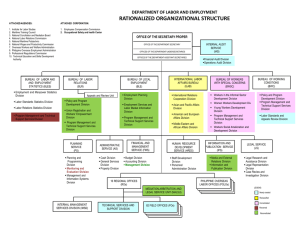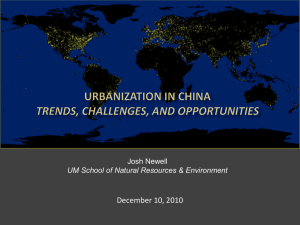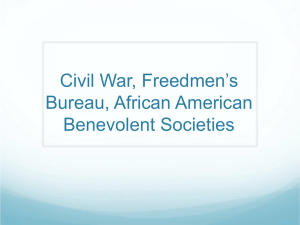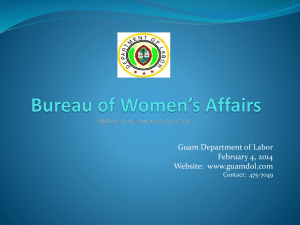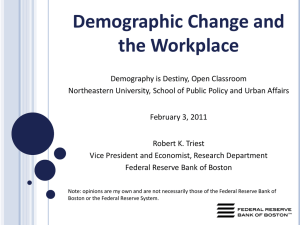Update on Dodd-Frank - Payday Loan Bar Association
advertisement
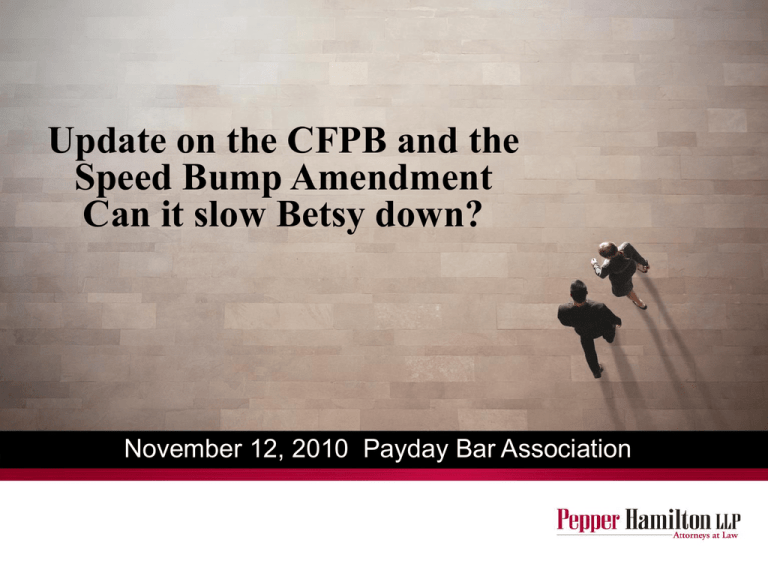
Update on the CFPB and the Speed Bump Amendment Can it slow Betsy down? November 12, 2010 Payday Bar Association Update on the Dodd-Frank Act • President Obama signed the Dodd-Frank Wall Street Reform and Consumer Protections Act into law on July 21, 2010. • Treasury has announced that the Bureau of Consumer Financial Protection, the new agency created by the Act, will assume the consumer financial protection regulatory functions of the banking agencies and the other agencies (HUD and FTC) on July 21, 2011. • Elizabeth Warren named special assistant to the President and Treasury Secretary to lead the establishment of the Bureau. • Warren is expected to be aggressive in interpreting the powers of the Bureau, and will strongly influence rulemaking and the selection of the first director. • She has said her first targets will include credit-card marketing. 2 Update on the Dodd-Frank Act • Between now and July 2011, the Bureau will: − Research current consumer financial products and services − Develop a national consumer complaint response center − Begin integrating examiners from the Fed, FDIC, OCC, OTS, and NCUA into the Bureau − Begin implementing supervision of non-depository covered persons (payday lenders, mortgage lenders, debt collectors, consumer reporting agencies, etc.) − Prepare for opening outreach offices and taking other administrative and logistical steps needed to begin operations. − Combine TILA/RESPA Forms 3 What will the Bureau Look Like? • Bureau’s estimated budget is $550 million • FTC budget for Fiscal Year 2011- $314 million • FTC employees- 1207 FTE for 2011 • SEC budget $943 million (FY 2008) • SEC employees-3,700 FTE • FTE for Bureau-2250 (est.); currently has hired around 50 − Headquarters in Washington, D.C. − Regional offices around the US: 7-9 • Likely each one will have a regional director • Legal staff, examiners and investigators 4 Can the Bureau Handle the Task? • Bureau staffing is 40% smaller than the SEC • Will take a while for Bureau to staff up fully • Jurisdiction of the Bureau is much larger than SEC • SEC oversees 35,000 companies and entities − 12,000 public companies − 8,000 mutual funds − 11,000 investment advisors − 5,500 broker dealers • Bureau may end up with jurisdiction over 50,000 institutions 5 Bureau Authority To Regulate Payday Lenders • Section 1024 authorizes the Bureau to require reports and conduct examinations of any entity that offers a consumer a payday loan. − To assess compliance with Federal consumer laws; − To obtain information about activities or compliance systems or procedures − To detect and assess risks to consumers 6 • Bureau shall prescribe rules to facilitate the supervision of payday lenders • Bureau has exclusive authority to prescribe rules, issue guidance, conduct examinations, require reports or issue exemptions for payday lenders vis a vis other federal agencies 7 Impact of Bureau’s Rules on Payday Lenders • Payday Industry was successful in getting the “Small Business Fairness and Regulatory Transparency Amendment added the Dodd Frank • Sponsored by Senators Pryor and Snowe, and included as Section 1100G of the DFA, the amendment makes a simple change to the Small Business Regulatory Enforcement Fairness Act of 1996 (“SBREFA”) by adding the CFPB to the list of agencies (OSHA and the EPA) subject to its requirements 8 What does SBREFA Require • SBREFA was enacted in 1996 to amend the Federal Regulatory Flexibility Act or “RFA”. • SBREFA amended the RFA acknowledging the poor compliance record of federal agencies in assessing and mitigating the disproportionate cost of federal regulation on small businesses • SBREFA compels the EPA and OSHA, and now the Bureau to convene small business advocacy review panels to assess proposed regulations that are expected to have a significant impact on a substantial number of small businesses 9 What is a small business under the RFA • For purposes of the SBREFA process, a small business is defined by reference to a table of types of businesses promulgated by the SBA • For financial institutions , the cut off is $175 million in assets • For “consumer lenders” the cut off is $7 million in receipts 10 How Does the SBREFA Process Work? • Determination must be made by the Bureau that a proposed regulation is expected to have a significant impact on a substantial number of small entities. • “Significant” and “substantial” are subject to much interpretation since they are not defined. • When the Bureau issues a rulemaking proposal, the RFA requires it to “prepare and make available for public comment an initial regulatory flexibility analysis” that describes the impact of the rule on small entities. 11 The SBREFA Process • If the Bureau says it does not, it must provide factual support for that lack of certification • That process can be challenged in court to determine the adequacy of the certification process • If the Bureau decides that the proposed rule will have a substantial impact it is required to prepare an initial regulatory flexibility analysis on the proposal (IRFA) • The Bureau must also convene a SBREFA panel before the publication of the proposed rule 12 The SBREFA Panel • Consists of a Bureau representative, someone for OMB, and the Chief Counsel of the Office of Advocacy of the SBA • The panel solicits advice from small entity representatives to enable the panel to better understand the ramifications of the proposed rule. • Panel must convene and complete its report within a 60 day period from the date it is formally convened. • Panel required to develop and recommend less burdensome alternatives to a proposal such as phased in deadlines, reduced obligations, or exemptions for small businesses. 13 Bureau Response to SBREFA Panel • The Bureau need not take the recommendations of the Panel, but must offer some explanation for its basis in adopting or rejecting the suggested alternatives • This response becomes part of the administrative record subject to judicial review if challenged 14 SBREFA Issues • Lack of definition of “significant impact” or “substantial number” of entities affected • The SBA Advocacy office views these terms as not absolutes requiring consideration of: − Size of the business − Profitability • Does it eliminate more than 10% of the businesses profits • Exceed 1% of the gross revenues of the entities involved • Exceed 5% of the labor costs of entities in the sector 15 Bureau is Learning About SBREFA • SBA Office of Advocacy is hosting a Small Business Roundtable on November 18th to discuss the SBREFA Panel process and the CFPB • Also will discuss the Federal Reserve’s proposed rule on Regulation Z and its costs on small businesses and what feasible alternatives may be available 16 Whistleblower Protection • Whistleblower protection (Sec. 1057) − Cannot terminate or discriminate against any employee that provides information to the Bureau or law enforcement about violating a law enforced by the Bureau − Files complaint with US Dept of Labor-Sec decides matter − Appeal decision to US Circuit Court − Can assess all costs and expenses including attorney fees − Frivolous cases limited to $1,000 penalty 17 For more information, visit www.pepperlaw.com. 18
